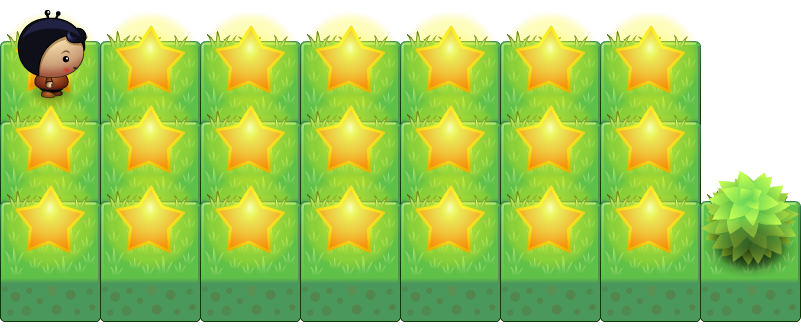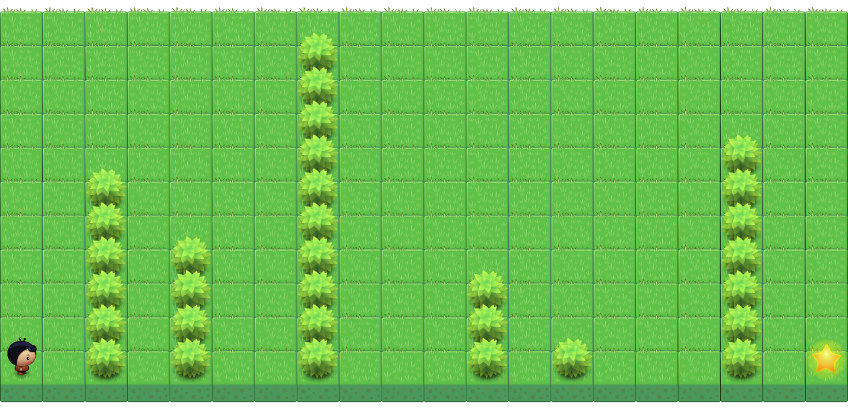With loops we have learned to repeat certain events while a condition is met. Now we want to do the following:
The player is to lay a trail of five stars.

This would, of course, be quite easy if we simple called putStar() and move() five times. But this is not very elegant. It would be nice if the player would count how many stars he has already placed. To do so, the player will need a “brain”, that means some kind of memory. Memory in programming can be used through the use of variables.
Counting with Variables
var i;
i = 0;
while (i < 5) {
putStar();
move();
i = i + 1;
}
Explanations
- With
var i;we reserve space for a variable namedi. We say: The variable i is declared. - With
i = 0;the variableiis assigned a value of0. Since it is the first assignment for the variable, we also say: The variable i is initialized. - Mostly, declaring and initializing a variable is done in a single step:
int i = 0; - For the condition
i < 5, the comparison operator<means less than (more comparison operators see tables below). - For the assignment
i = i + 1, we must first look at the right part. It means: “Take the current value of i, add 1 to it and save the new value again under the name i.”
More Information about Variables
- It is possible to create a variable with an unchangeable value, that means making it into a constant:
const anzahl = 5;
With this constant we could change the condition in the program above to
while (i < anzahl). - Variables always start with a lower case letter, just like function names.
Data Types in Dart
In Dart there are a few pre-defined data types. With data types we can specify what type of data we intend to store in a variable. This information is optional Dart. This means that we could declare all variables with the generic var, as we did above. But I recommend that you specify the data type most of the time. This helps to detect errors early as Dart will tell you when you try to put the wrong type of data into a variable.
Later, we will create our own classes. Let’s have a look at the basic data types of Dart.
For more information about the basic data types of Dart see Dart Up and Running - Chapter 2: Built-in types.
| Type | Description | Example |
|---|---|---|
int |
Integer values | 1, 2, -1233123 |
double |
Floating-point numbers | 0.5, -333.234 |
String |
Text of arbitrary length. Either singel or double quotes can be used to create a string. | 'I am a text' or "I am also a text" |
bool |
A boolean is a logic value that can either be true or false. | true or false |
List |
A collection of objects. Lists are sometimes also called arrays. | [1, 2, 3] |
Map |
A map is an object that associates keys and values. | { 'key-1': 'value-1', 'key-2': 'value-2' } |
Comparison Operators
The following operators can be used for comparisons in Dart. The result of each expression is always a bool, that means it is either true or false.
| Operator | Description | Example |
|---|---|---|
== |
equal | k == 2 |
!= |
unequal | k != 12 |
> |
greater than | k > 67 |
< |
less than | k < 12 |
>= |
greater than or equal to | k >= 45 |
<= |
less than or equal to | k <= 23 |
Arithmetic Operators
For calculations we use the following arithmetic operators.
| Operator | Description | Example |
|---|---|---|
+ |
Add | h = w + 34 |
- |
Subtract | y = 3.4 – t |
* |
Multiply | z = h * 3.56 |
/ |
Divide | d = m / v |
% |
Modulo (the remainder of an integer division) | count = w % 2 |
TASK 4.01: Counting Stars

The player is to move from the left to the right and count all the stars.
Hints:
- Define and initialize a variable, for example like
int count = 0; - Below it write a loop that increments the variable by one:
count = count + 1; - The variable should only be incremented when the player is on a star.
- At the end the player should tell us how many stars he counted. With
${count}we can include a variable inside a text:
say('I have found ${count} stars.');
TASK 4.02: Cleaning Up

The player is to remove all the stars.
Hints:
- You can use the tree to find out when the player is at the end with a
while (!treeFront()) {...}loop. - First remove the stars in the first row.
- Turn at the border and remove the stars of the second line.
- Now introduce a
boolvariable, so that the player can remember in which direction he is facing, for example like the following:
bool goingRight = true; - With the help of this variable you can now find out if the player reaches the left or the right border and turn accordingly. A
boolcan be included in a condition as follows:
if (goingRight) {...} - Remember to save the new direction to the variable whenever the player turns:
goingRight = false; - Improvement: To make the code more readable you could create two functions for turning around:
turnAroundRight()andturnAroundLeft().
TASK 4.03: Inverting

The world is a square and has a tree at the end. Within the world there is a pattern of stars that is to be inverted by the player. Make sure that your code stays clear by extracting parts into their own functions.
TASK 4.04: Chessboard

The world is a square and has a tree at the end. The player is to create a chessboard pattern with stars.
TASK 4.05 (difficult): Tree Line

In this world there are several rows of trees. The player is to determine the length (in number of trees) of the longest line of trees and report the result. Between the rows of trees is always at least one empty row. A star marks the end of the world.
What’s next?
→ Continue with Part 5: Functions
Credits
Planet Cute images by Daniel Cook (Lostgarden.com), published under CC BY 3.0.
Oleg Yadrov improved the “Planet Cute” images and was so kind to let me use them. The images were optimized with the great TexturePacker.
Some exercises in Hello Dartwere inspired by Kara. Kara was developed by Jürg Nievergelt, Werner Hartmann, Raimond Reichert et. al.